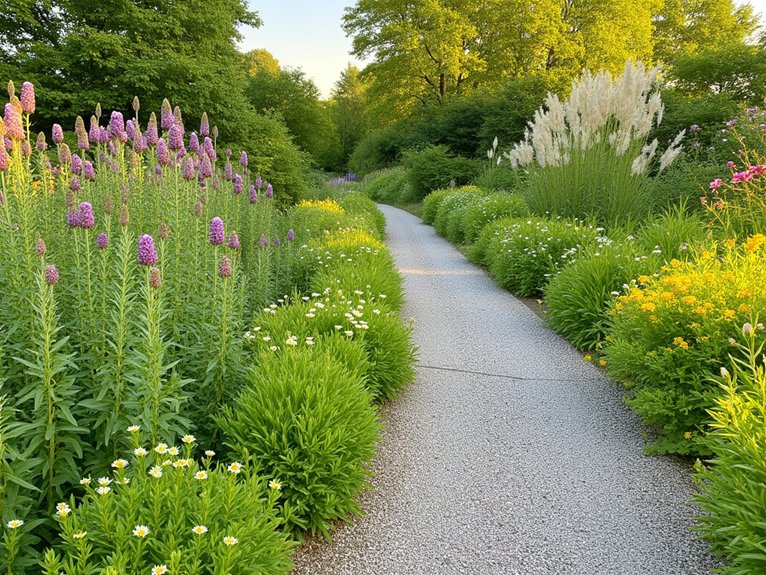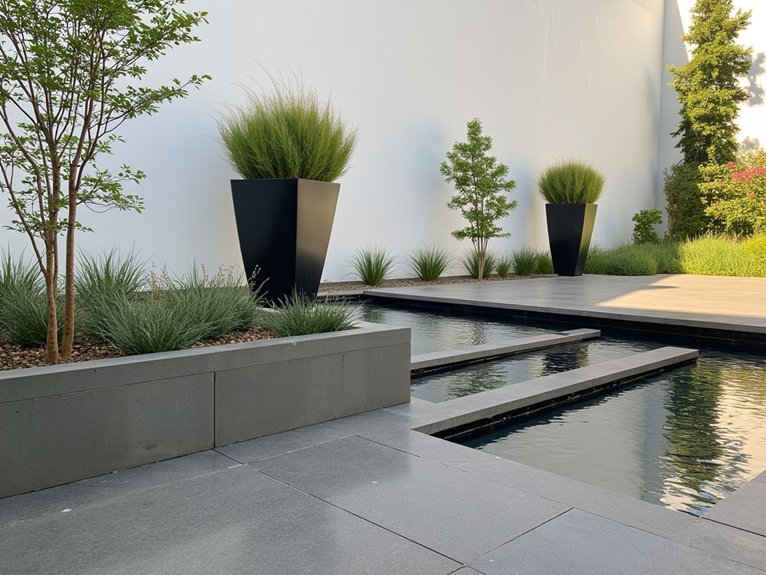While a formal garden demands precise geometry and carefully trimmed hedges, your perfect garden style might embrace wild meadow flowers and meandering paths. You’ll discover that finding your ideal design isn’t just about following trends – it’s about matching your outdoor space to your lifestyle and personality. “Gardens should reflect the soul of their creators,” notes landscape architect Sarah Bennett. Let’s explore how to transform your yard into a personalized sanctuary that you’ll cherish for years to come.
Contents
Understanding Garden Design Philosophy

While creating your perfect garden may seem intimidating at first, understanding basic design philosophy will help guide your decisions throughout the process. You’ll need to reflect on your personal style preferences alongside practical factors like climate and maintenance requirements.
Start by identifying garden colors that resonate with you and how you’ll want to experience the space. Your plant selection should reflect both aesthetic goals and site conditions. Whether you’re drawn to formal symmetry or casual cottage charm, your garden’s design will flow naturally when you align it with your tastes and lifestyle needs.
The Art of Formal Garden Planning
Formal gardens bring timeless elegance to any landscape through carefully planned geometric designs and precise plant placement. You’ll want to start by establishing strong garden structure using boxwood hedges and topiaries to create defined spaces and walkways. Plant symmetry is essential – mirror your plantings on both sides of a central axis for that classic formal look.
Consider incorporating geometric flower beds filled with uniform plantings of roses or tulips. You’ll need to maintain clean edges and regular pruning to keep everything orderly. For the best visual impact, place taller elements like sculpted junipers toward the center or back of your design.
Creating a Natural Flow With Informal Gardens

Looking to create a more relaxed and free-flowing garden space? An informal garden style might be perfect for you. Unlike formal gardens, informal designs embrace natural curves and welcome spontaneous plant combinations throughout the seasons.
You’ll find success by mixing different plant heights, textures, and bloom times. Let daylilies mingle with catmint, while lilacs provide dramatic spring color and height. As seasonal changes occur, self-seeding flowers like daisies fill empty spaces naturally.
Don’t worry about perfect symmetry – informal gardens thrive on variety. Create winding paths and allow plants to spill over edges, creating a living tapestry that changes with each passing month.
Embracing Wildlife in Naturalistic Landscapes
Taking your garden beyond informal beauty opens up exciting possibilities for supporting local wildlife. When you incorporate native plants like coneflowers and marsh marigolds, you’ll create natural wildlife habitats that attract beneficial creatures to your landscape.
You don’t need a large space to make an impact. Consider adding:
- Dense shrubs for bird nesting
- Shallow water features for pollinators
- Native grasses for cover and food sources
- Rock piles for small reptiles
“Native plantings naturally support local ecosystems,” explains botanist Dr. Sarah Chen. “Even small gardens can become essential corridors for wildlife movement and survival.”
Modern Garden Elements and Minimalism

When minimalism meets gardening, the result is a striking modern landscape defined by clean lines and intentional simplicity. You’ll find geometric patterns dominating these spaces, from straight-edged planting beds to perfectly spaced rows of ornamental grasses.
To achieve this look, focus on minimalist materials like polished concrete, steel edging, and large paving stones. Select just 3-4 plant varieties and repeat them throughout your design. Japanese holly and sedum work especially well, as they maintain clean shapes with minimal pruning.
“Modern gardens celebrate restraint,” says landscape architect Sarah Chen. “Let each element have room to breathe.”
Designing a Whimsical Cottage Garden
Yearning to create a garden that feels like stepping into a storybook? The cottage garden style brings whimsical elements through abundant flowers, overflowing beds, and charming pathways.
Start by mixing heights and textures – tall hollyhocks (4-6 feet) in the back, mid-height peonies (2-3 feet) in the middle, and low-growing catmint (12-18 inches) in front. Add cottage aesthetics with a white picket fence, rustic arbor, or weathered birdbath.
Plant flowers close together, letting them spill into each other naturally. Include climbing roses on trellises, self-seeding annuals, and fragrant herbs like lavender and thyme throughout your beds.
Choosing Your Garden’s Unique Identity
How does your perfect garden reflect who you are and what brings you joy? Your garden’s unique identity emerges from your personal connection to different garden aesthetics and how you’ll use the space. Consider which style resonates with your lifestyle – whether it’s the precise geometry of formal gardens or the wild beauty of naturalistic landscapes.
Start by evaluating your maintenance preferences and climate requirements. Your plant selection should match both your visual preferences and practical needs. Remember, you’re not locked into just one style – you can blend elements from different approaches to create a space that’s distinctly yours.
